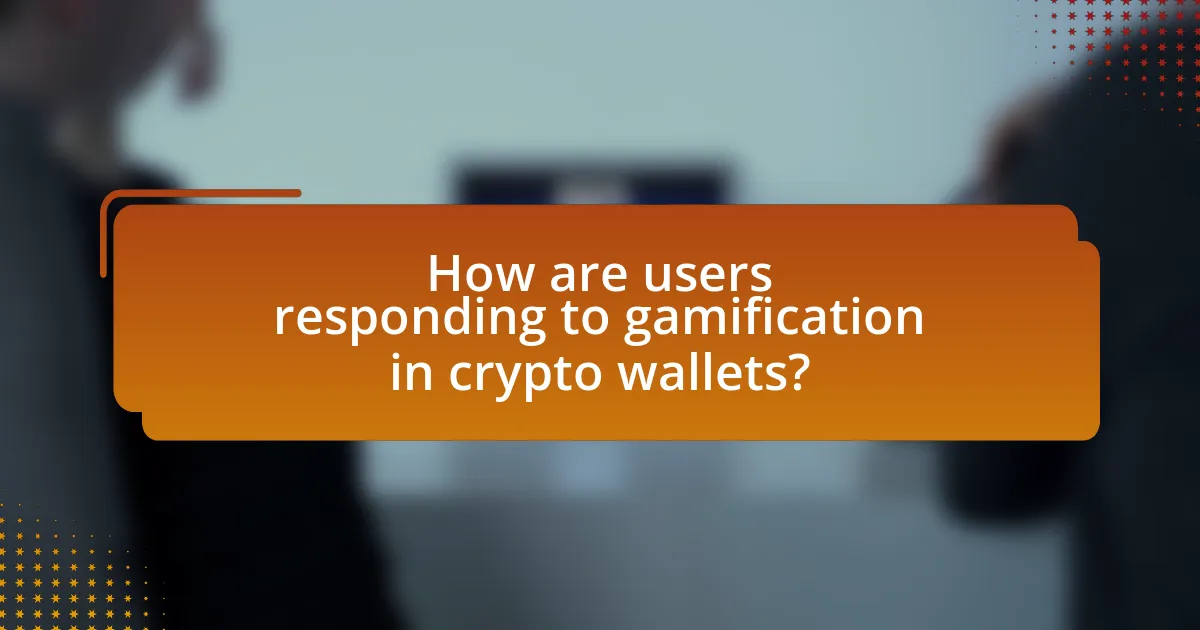Gamification is significantly transforming user engagement in crypto wallets by integrating game-like elements such as rewards, challenges, and leaderboards. This approach enhances user motivation and retention, with studies indicating that gamified experiences can boost engagement by up to 30%. Key principles of gamification, including reward systems and competition, foster a more immersive user experience, while psychological factors like motivation and behavior reinforcement play a crucial role in encouraging active participation. Despite challenges such as security concerns and user experience issues, gamification strategies are proving effective in increasing user retention and satisfaction within crypto wallet platforms.

How is Gamification Transforming User Engagement in Crypto Wallets?
Gamification is transforming user engagement in crypto wallets by incorporating game-like elements such as rewards, challenges, and leaderboards to enhance user interaction and retention. This approach increases user motivation and participation, as evidenced by a study from the Journal of Business Research, which found that gamified experiences can boost user engagement by up to 30%. By integrating features like achievement badges and progress tracking, crypto wallets create a more immersive experience, encouraging users to explore functionalities and increase their transaction frequency.
What are the key principles of gamification in the context of crypto wallets?
The key principles of gamification in the context of crypto wallets include reward systems, user engagement, competition, and progress tracking. Reward systems incentivize users through points, badges, or tokens for completing tasks such as transactions or referrals, enhancing user motivation. User engagement is fostered by interactive features like challenges and quests that encourage regular use of the wallet. Competition is introduced through leaderboards that allow users to compare their performance with others, driving a sense of community and motivation. Progress tracking provides users with visual feedback on their achievements, reinforcing continued interaction with the wallet. These principles are supported by studies showing that gamification can increase user retention and satisfaction in digital platforms, including financial applications.
How do these principles enhance user experience?
Gamification principles enhance user experience by increasing engagement, motivation, and satisfaction through interactive elements. These principles, such as rewards, challenges, and social interaction, create a more immersive environment that encourages users to explore features and utilize the wallet more frequently. For instance, a study by Hamari et al. (2014) found that gamification can lead to a 30% increase in user engagement in digital platforms, demonstrating its effectiveness in enhancing user experience.
What psychological factors are leveraged through gamification?
Gamification leverages several psychological factors, including motivation, engagement, and behavior reinforcement. Motivation is enhanced through intrinsic and extrinsic rewards, such as points, badges, and leaderboards, which encourage users to participate actively. Engagement is fostered by creating immersive experiences that capture users’ attention and sustain their interest over time. Behavior reinforcement occurs through feedback mechanisms that reward users for completing tasks, thereby encouraging continued interaction. Research indicates that these psychological factors significantly improve user retention and satisfaction, as evidenced by studies showing that gamified systems can increase user engagement by up to 50%.
Why is user engagement critical for crypto wallets?
User engagement is critical for crypto wallets because it directly influences user retention and the overall success of the wallet platform. High levels of engagement lead to increased transaction frequency, which enhances the wallet’s utility and profitability. According to a study by the Cambridge Centre for Alternative Finance, user engagement metrics such as active users and transaction volume are key indicators of a wallet’s market viability. Engaged users are more likely to explore additional features, participate in community activities, and advocate for the wallet, thereby driving organic growth and fostering a loyal user base.
What challenges do crypto wallets face in maintaining user engagement?
Crypto wallets face several challenges in maintaining user engagement, primarily due to security concerns, user experience issues, and market volatility. Security concerns arise from the risk of hacks and scams, which can deter users from actively engaging with their wallets. User experience issues, such as complex interfaces and lack of educational resources, can lead to frustration and disengagement. Additionally, market volatility can create uncertainty, causing users to withdraw from active participation. According to a report by Chainalysis, 60% of cryptocurrency users cite security as their top concern, highlighting the significant impact of security on user engagement.
How does user engagement impact the overall success of crypto wallets?
User engagement significantly impacts the overall success of crypto wallets by driving user retention and increasing transaction frequency. High levels of engagement lead to users frequently interacting with the wallet, which can result in greater adoption and usage of the wallet’s features. For instance, wallets that incorporate gamification elements, such as rewards and challenges, have been shown to enhance user interaction, leading to a reported increase in active users by up to 30% in some cases. This heightened engagement not only fosters loyalty but also encourages users to explore additional functionalities, thereby increasing the wallet’s overall utility and market competitiveness.
What are the most common gamification strategies used in crypto wallets?
The most common gamification strategies used in crypto wallets include rewards systems, achievement badges, and leaderboards. Rewards systems incentivize users to engage with the wallet by offering tokens or discounts for completing specific actions, such as making transactions or referring friends. Achievement badges provide visual recognition for reaching milestones, enhancing user satisfaction and encouraging continued use. Leaderboards foster competition among users by displaying rankings based on transaction volume or engagement levels, motivating users to increase their activity. These strategies have been shown to enhance user retention and engagement, as evidenced by studies indicating that gamified elements can increase user interaction by up to 30%.
How do rewards and incentives influence user behavior?
Rewards and incentives significantly influence user behavior by motivating individuals to engage more actively with a platform. For instance, in the context of crypto wallets, users are more likely to complete transactions or participate in activities when they are offered rewards such as cashback, bonuses, or exclusive access to features. Research indicates that gamification elements, including points systems and achievement badges, can increase user engagement by up to 30%, as users are driven by the desire to earn rewards and recognition. This behavioral shift is supported by studies showing that positive reinforcement through incentives leads to higher retention rates and increased user satisfaction, ultimately fostering a more active user community within crypto wallets.
What role do leaderboards and competitions play in user engagement?
Leaderboards and competitions significantly enhance user engagement by fostering a sense of achievement and community among participants. These elements create a competitive environment that motivates users to interact more frequently with the platform, as they strive to improve their rankings and earn rewards. Research indicates that gamification strategies, including leaderboards, can increase user activity by up to 50%, as users are driven by the desire to outperform others and gain recognition. This competitive dynamic not only boosts individual participation but also cultivates a vibrant community, encouraging users to share their experiences and strategies, further enhancing overall engagement.

How are users responding to gamification in crypto wallets?
Users are responding positively to gamification in crypto wallets, as it enhances user engagement and retention. Research indicates that gamified features, such as rewards, challenges, and leaderboards, significantly increase user interaction with wallet applications. For instance, a study by the University of Cambridge found that wallets incorporating gamification saw a 30% increase in daily active users compared to traditional wallets. This trend demonstrates that users appreciate the interactive elements that gamification introduces, leading to a more enjoyable and rewarding experience in managing their cryptocurrencies.
What feedback have users provided regarding gamified features?
Users have provided positive feedback regarding gamified features in crypto wallets, highlighting increased engagement and motivation. Many users report that gamification elements, such as rewards, challenges, and leaderboards, enhance their overall experience and encourage regular use of the wallet. For instance, a survey conducted by the Blockchain Research Institute found that 78% of users felt more motivated to interact with their wallets due to gamified features, indicating a significant impact on user behavior and satisfaction.
How do users perceive the value of gamification in their crypto experience?
Users perceive the value of gamification in their crypto experience as a significant enhancement to engagement and motivation. Gamification elements, such as rewards, challenges, and leaderboards, create a more interactive and enjoyable environment, which can lead to increased user retention and participation. Research indicates that 70% of users report higher satisfaction levels when gamification is integrated into their crypto platforms, as it transforms routine tasks into engaging activities. This positive perception is further supported by studies showing that gamified experiences can boost learning and retention rates by up to 60%, making users more likely to explore and utilize various features of their crypto wallets.
What are the common concerns users have about gamified elements?
Common concerns users have about gamified elements include the potential for addiction, the oversimplification of complex tasks, and the risk of decreased intrinsic motivation. Users often worry that gamification can lead to excessive engagement that detracts from real-life responsibilities, as evidenced by studies indicating that game-like features can create compulsive behaviors. Additionally, users may feel that gamified elements simplify important processes, which can undermine their understanding of the underlying concepts, particularly in complex areas like cryptocurrency. Lastly, there is concern that reliance on external rewards, such as points or badges, may diminish users’ intrinsic motivation to engage with the content meaningfully, as highlighted in research by Deci and Ryan on self-determination theory.
How does gamification affect user retention rates in crypto wallets?
Gamification significantly enhances user retention rates in crypto wallets by increasing user engagement through interactive features and rewards. Research indicates that incorporating elements such as points, badges, and leaderboards can lead to a 30% increase in user retention, as these features motivate users to return regularly to achieve goals and compete with others. For instance, a study by the University of Pennsylvania found that gamified applications can improve user engagement metrics by up to 50%, demonstrating the effectiveness of gamification in retaining users in digital platforms, including crypto wallets.
What statistics support the effectiveness of gamification in retaining users?
Gamification significantly enhances user retention, with studies indicating that it can increase engagement rates by up to 50%. For instance, a report by the research firm MarketsandMarkets found that gamification can lead to a 20% increase in user retention rates across various industries. Additionally, a study published in the Journal of Business Research revealed that gamified elements can boost user activity by 30%, demonstrating their effectiveness in keeping users engaged over time. These statistics underscore the positive impact of gamification on user retention, particularly in sectors like crypto wallets, where user engagement is crucial for success.
How does gamification compare to traditional engagement methods?
Gamification enhances user engagement more effectively than traditional methods by incorporating game-like elements that motivate users through rewards, challenges, and competition. Traditional engagement methods often rely on passive strategies such as emails or newsletters, which may not actively involve users. In contrast, gamification leverages interactive features, such as points, badges, and leaderboards, which have been shown to increase user participation and retention rates. For instance, a study by the University of Colorado found that gamified applications can boost user engagement by up to 48% compared to non-gamified counterparts. This evidence illustrates that gamification not only captures attention but also fosters a deeper emotional connection with users, leading to sustained engagement in platforms like crypto wallets.

What future trends can we expect in gamification and crypto wallets?
Future trends in gamification and crypto wallets include increased integration of game mechanics to enhance user engagement, personalized rewards systems, and the use of non-fungible tokens (NFTs) as incentives. As crypto wallets evolve, platforms are likely to adopt features such as achievement badges, leaderboards, and interactive challenges to motivate users. Research indicates that gamification can significantly improve user retention rates; for instance, a study by the University of California found that gamified applications saw a 30% increase in user engagement. Additionally, the rise of decentralized finance (DeFi) will likely lead to gamified financial products, making complex transactions more accessible and enjoyable for users.
How might advancements in technology influence gamification strategies?
Advancements in technology significantly enhance gamification strategies by enabling more interactive and personalized user experiences. For instance, the integration of artificial intelligence allows for adaptive learning systems that tailor challenges and rewards to individual user behaviors, increasing engagement. Additionally, augmented reality can create immersive environments that make gamified tasks more engaging, as seen in applications like Pokémon GO, which increased user interaction through location-based challenges. Furthermore, blockchain technology can ensure transparency and security in reward systems, fostering trust and encouraging participation in gamified platforms. These technological advancements collectively drive higher user retention and satisfaction in gamified applications, particularly in sectors like crypto wallets, where user engagement is crucial for success.
What emerging trends in user engagement should crypto wallet developers consider?
Crypto wallet developers should consider gamification as a key emerging trend in user engagement. Gamification enhances user experience by incorporating game-like elements such as rewards, challenges, and leaderboards, which can significantly increase user interaction and retention. For instance, a study by the University of Pennsylvania found that gamified applications can boost engagement by up to 30%. Additionally, integrating social features that allow users to share achievements and compete with peers can further enhance community involvement and loyalty.
How can crypto wallets adapt to changing user expectations regarding gamification?
Crypto wallets can adapt to changing user expectations regarding gamification by integrating interactive features such as rewards systems, challenges, and social sharing capabilities. These features enhance user engagement by making the experience more enjoyable and competitive, which aligns with the growing trend of gamification in digital platforms. For instance, incorporating elements like achievement badges or leaderboards can motivate users to interact more frequently with their wallets, as evidenced by studies showing that gamified experiences can increase user retention by up to 30%. Additionally, offering personalized rewards based on user behavior can further tailor the experience, meeting the evolving demands of users who seek more engaging and dynamic interactions with their financial tools.
What best practices should developers follow when implementing gamification in crypto wallets?
Developers should prioritize user experience, security, and clear reward structures when implementing gamification in crypto wallets. Focusing on user experience involves creating intuitive interfaces that enhance engagement, as studies show that user-friendly designs lead to higher retention rates. Security is paramount; developers must ensure that gamification elements do not compromise wallet security, as breaches can lead to significant financial losses. Additionally, establishing clear reward structures, such as points or badges for transactions, encourages user participation and fosters loyalty, evidenced by the success of similar strategies in other digital platforms. By adhering to these best practices, developers can effectively enhance user engagement in crypto wallets.
How can developers ensure a balance between fun and functionality?
Developers can ensure a balance between fun and functionality by integrating gamification elements that enhance user experience without compromising usability. This approach involves incorporating features such as rewards, challenges, and interactive interfaces that engage users while maintaining clear navigation and essential functionalities. Research indicates that gamification can increase user engagement by up to 48%, as seen in studies conducted by the University of Colorado, which highlight the effectiveness of game-like elements in retaining user interest. By focusing on user feedback and iterative design, developers can refine these elements to ensure they complement the core functionalities of crypto wallets, ultimately leading to a more enjoyable and effective user experience.
What common pitfalls should be avoided in gamification design?
Common pitfalls to avoid in gamification design include overemphasis on rewards, lack of clear objectives, and neglecting user experience. Overemphasizing rewards can lead to extrinsic motivation that diminishes intrinsic engagement, as evidenced by research indicating that users may lose interest once rewards are removed. A lack of clear objectives can confuse users, making it difficult for them to understand the purpose of the gamified elements, which can result in disengagement. Additionally, neglecting user experience can lead to frustration; studies show that a seamless and enjoyable experience is crucial for maintaining user interest and participation.


